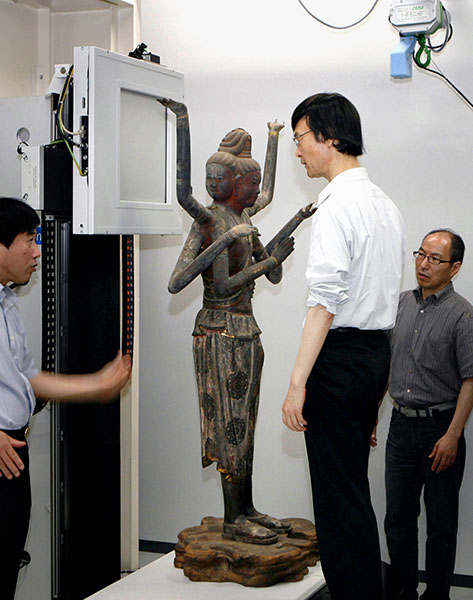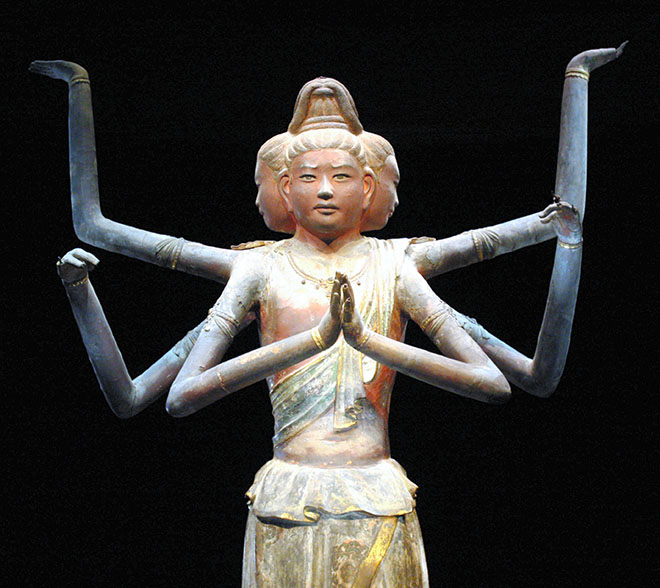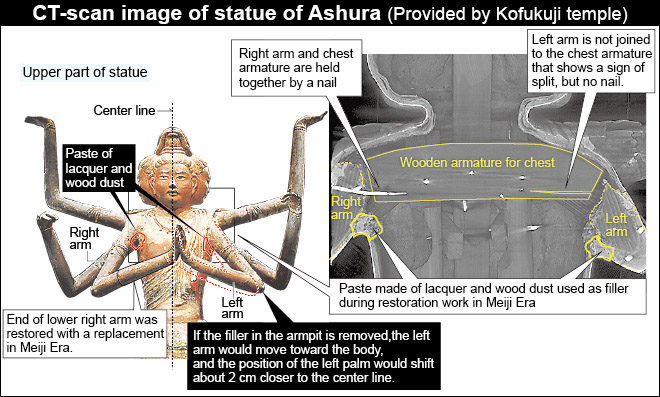DepthReading
Riddle of famed ancient statue finally solved with CT scans?
Researchers take CT scans of the statue of Ashura at the Kyushu National Museum in Dazaifu, Fukuoka Prefeture, in July 2009. (Asahi Shimbun file photo)
The statue of Ashura from Kofukuji temple in Nara (Asahi Shimbun file photo)
The Asahi Shimbun
DAZAIFU, Fukuoka Prefecture--CT scanning of one of the best-known ancient Buddhist artworks in Japan revealed repairs and damage that offer a new perspective on the original position of the statue's many arms.
The three-headed and six-armed Ashura has been in the possession of Kofukuji temple in Nara for over 1,300 years, and is designated as a national treasure by the government.
A team of experts, including researchers from Kyushu National Museum here, spent seven years analyzing CT images of the statue. The images revealed details of repair work done in the Meiji Era (1868-1912) that rejoined arms, and provided clues to the statue's original form, a subject of much debate over the years.
After a test using a replica chest armature, the team concluded it is most likely that the statue originally joined palms of its frontal arms together in the center, rather than holding some kind of object between the raised open hands.
The statue was made in parts by layering patches of “urushi” lacquered textile on clay molds, and removing the clay when the lacquer had hardened.
The statue, made in 734, had survived a number of fires, earthquakes and wars through the centuries, but at the cost of some of the six arms.
From 1902 to 1905, it underwent extensive repair work and a new lower arm was made for the missing part of the right frontal arm. Ever since those repairs, the frontal hands have been joined together slightly off center to the left, and some scholars suggested it is because the statue was once holding some kind of Buddhist instrument or treasure between its hands.
CT scanning was carried out at Kyushu National Museum in 2009 to coincide with a touring exhibition of the statue to the museum. Shows at that museum and the Tokyo National Museum drew a combined audience of 1.65 million.
Setsuo Imazu, a professor of conservation science at Nara University, and other researchers spent the intervening years since then to analyze the scanned images.
The analysis revealed that paste made of a mixture of lacquer and wood dust was used to fill in both armpits of the frontal arms during the Meiji repair work, and that the filler is pushing up both elbows slightly outward.
Using a model of the statue, the researchers found that if the lacquer filler in the left armpit is removed so that the left arm returns to its original position, the left palm will shift about 2 centimeters inward, and almost align to the center of the body.
The right arm will also move closer to the body, making it harder for any pose other than raised palms together, according to the team.
“The likelihood that the statue of Ashura joined palms in a more natural posture seems much more realistic,” said Hiroaki Kaneko, curator emeritus at the Tokyo National Museum, who specializes in art history of Japanese sculpture. “It is a significant discovery that was made by non-invasive, state-of-the-art technology.”
Category: English
DepthReading
Key words:



